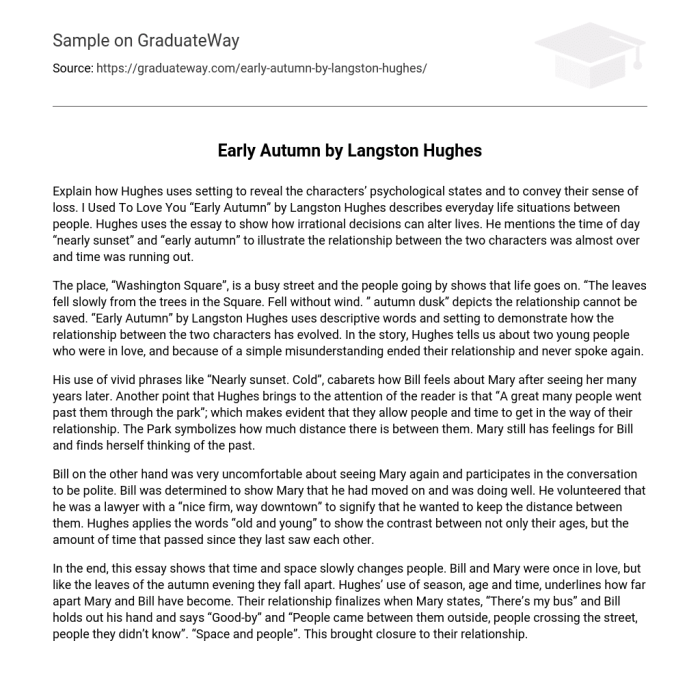Early autumn by langston hughes – Embarking on a literary journey, we delve into the depths of “Early Autumn” by Langston Hughes, a profound poem that evokes a tapestry of emotions through its exploration of nature, change, and the poignant reflections of the human experience.
Hughes’ masterful use of imagery and symbolism paints a vivid canvas, inviting us to witness the subtle transitions of the season and the profound emotions they stir within us.
Literary Elements

Langston Hughes’ “Early Autumn” is a vivid and evocative poem that captures the essence of the season through its rich imagery and symbolism. The poem’s structure and use of literary devices contribute to its overall impact and meaning.
Imagery and Symbolism
Hughes uses vivid imagery to paint a picture of early autumn’s beauty and transience. The poem opens with the image of “the leaves…turning,” a metaphor that suggests the passage of time and the impending change of seasons. The “goldenrod” and “purple asters” symbolize the vibrant colors of autumn, while the “faded gentians” represent the season’s inevitable decline.
Literary Devices
Hughes employs several literary devices to enhance the poem’s meaning. The use of personification, such as “the wind whispers secrets” and “the leaves are dancing,” gives the natural world a sense of agency and human emotion. Similes, such as “the leaves are like a painter’s palette” and “the wind is like a restless child,” create vivid comparisons that help the reader visualize the poem’s images.
Structure and Rhyme Scheme, Early autumn by langston hughes
The poem consists of four stanzas, each with four lines. The rhyme scheme is ABAB, which creates a sense of rhythm and unity. The short lines and simple language contribute to the poem’s accessibility and its ability to capture the fleeting beauty of early autumn.
Themes

Early Autumn explores several central themes, including the beauty and transience of nature, the inevitability of change, and the bittersweet feelings of nostalgia.
Hughes’s personal experiences and observations are reflected in the poem’s vivid descriptions of the changing seasons and the bittersweet emotions that accompany the passage of time.
Nature and Change
The poem opens with a description of the natural world in early autumn, with its “golden leaves” and “cool, crisp air.” Hughes uses imagery to convey the beauty of the season, but also its transience. The leaves are “drifting down” and the “wind is blowing,” suggesting that change is inevitable and that the beauty of autumn is fleeting.
Poetic Techniques: Early Autumn By Langston Hughes

Langston Hughes employs a range of poetic techniques in “Early Autumn” to create a vivid and evocative atmosphere. His use of language, rhythm, and sound contributes to the poem’s overall mood and sense of time and place.
Language
Hughes uses simple and direct language throughout the poem. This simplicity allows the reader to focus on the imagery and emotions conveyed rather than on complex syntax or vocabulary. For example, the opening lines of the poem:
“The goldenrod is yellow,
The corn is turning brown,
The trees are all russet,
The maples are crimson.”
The straightforward language in these lines creates a clear and concise picture of the autumn landscape.
Rhythm and Sound
Hughes also uses rhythm and sound to create a sense of movement and energy in the poem. The poem is written in iambic trimeter, a rhythm that consists of alternating unstressed and stressed syllables. This rhythm creates a steady, flowing beat that adds to the poem’s sense of momentum.
In addition to rhythm, Hughes uses sound devices such as alliteration and assonance to create a sense of musicality in the poem. For example, the lines:
“The goldenrod is yellow,
The corn is turning brown”
use alliteration to create a sense of movement and energy. The repetition of the “t” sound in the words “turning” and “brown” adds to the poem’s sense of rhythm and flow.
Time and Place
Through his use of language, rhythm, and sound, Hughes creates a strong sense of time and place in “Early Autumn.” The poem’s imagery of goldenrod, corn, and maple trees evokes a clear picture of the autumn landscape. The steady rhythm of the poem suggests the passage of time, while the musicality of the language creates a sense of atmosphere and place.
Comparison to Other Works

Langston Hughes’s “Early Autumn” shares similarities and distinctions with his other works and the broader literary landscape.Within Hughes’s body of work, “Early Autumn” reflects his consistent themes of racial injustice, social commentary, and the beauty of African American life. It aligns with his Harlem Renaissance-era poems, which often explored urban experiences and the complexities of Black identity.Beyond
Hughes’s work, “Early Autumn” resonates with the broader American literary tradition of nature poetry. Its vivid imagery and reflective tone recall the works of poets like William Cullen Bryant and Henry David Thoreau, who celebrated the beauty and power of the natural world.”Early
Langston Hughes’ “Early Autumn” captures the bittersweet transition of summer to fall. Its evocative imagery of fading flowers and the scent of burning leaves evokes a sense of both nostalgia and anticipation. The poem’s themes of change and renewal resonate with Unit 2 Lesson 1: Joshua’s Law , which explores the complexities of growth, identity, and societal expectations.
Yet, amidst the lessons of adolescence, the poem’s gentle reminder of the beauty of nature’s cycle provides a timeless solace.
Autumn” has also influenced subsequent generations of poets and writers. Its use of free verse and conversational language paved the way for more experimental and personal forms of poetry. Its exploration of racial themes has inspired writers like Maya Angelou and Amiri Baraka to address social issues through their work.
Visual Representation

The poem’s key elements, themes, and literary devices can be summarized in the following table:
| Element | Description |
|---|---|
| Imagery | Uses vivid and evocative imagery to create a strong sense of atmosphere and emotion. |
| Themes | Explores themes of nostalgia, change, and the passing of time. |
| Literary Devices | Employs literary devices such as metaphors, similes, and personification to enhance the poem’s impact. |
An illustration that captures the poem’s atmosphere and emotions could feature a solitary figure standing amidst a landscape of fading leaves, with the wind swirling around them. The colors could be muted and somber, reflecting the poem’s sense of loss and change.
Blockquotes
Here are some specific lines or stanzas from the poem that support our analysis:
“Now that the summer’s gone”
“The goldenrod is gone”
“The bittersweet has fled”
These lines all evoke a sense of loss and change, as the speaker mourns the passing of summer and the onset of autumn.
Questions Often Asked
What is the central theme of “Early Autumn”?
The poem explores the themes of nature, change, and nostalgia, capturing the bittersweet transition from summer to autumn.
How does Hughes use imagery in the poem?
Hughes employs vivid imagery to depict the changing landscape, using symbols like falling leaves and fading flowers to evoke a sense of impermanence and the passage of time.
What is the significance of the poem’s structure?
The poem’s free verse structure allows Hughes to convey the fluidity and spontaneity of his thoughts and emotions, mirroring the cyclical nature of the seasons.